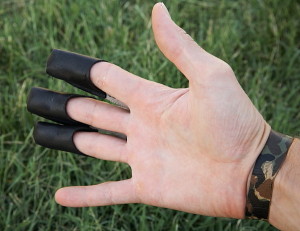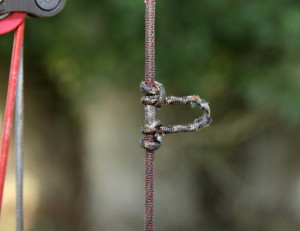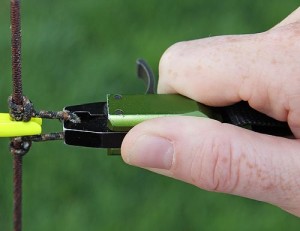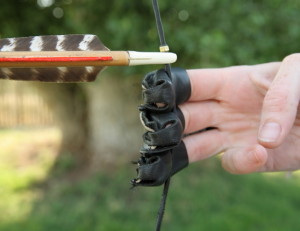Proper Arrow Release
The release arm, (aka the string arm or shooting arm), is the arm/hand that holds the string while drawing the bow. If you are right handed, then it’s your right hand.
In traditional archery you have the option of wearing a shooting glove or finger tab to protect your shooting fingers (index, middle, and ring finger).
Although it is perfectly fine to shoot with bare fingers on a light-poundage bow, it can be very painful with a heavier-poundage bow. A release “aid” or glove also allows the string to slide off the fingers evenly and with less friction.


All newer-model compound bows should be shot with a mechanical release aid. Unlike traditional bows (longbows and recurves), compound bows are designed to be shot in-line with the arrow, string, and rest.
With traditional bows, the string naturally oscillates from side to side as it comes off your fingers. This is normal, and the arrow will straighten itself out in flight.
With compound bows, the arrow leaves the bow at a much higher speeds, and therefore, oscillation will cause the arrow to wobble and shed energy as it tries to re-adjust itself in flight. Therefore, the arrow should be shot with perfect alignment to avoid any oscillation.
Compound Bow Release
In order to accomplish this, the arrow attaches to the bowstring inside of a D-loop that’s tied to the bowstring. Next, a mechanical release aid attaches to the D-loop to draw the bow back. This keeps the shooters arm aligned perfectly with the arrow.


As an aside, my person favorite release is the Fletcher .44 Caliper Release (no longer in production, but still available sometimes on Ebay. This is the smoothest, most reliable, and least expensive release I’ve used.
Traditional Archery Release
With traditional archery, you have two options for grasping the string: 1) One finger above and two below the arrow nock, or 2) Three fingers below the nock.
The advantage of having three fingers below is that it brings the arrow closer to your eye. This helps with aiming. I’ve personally found that three fingers below dramatically increases my accuracy. Try it both ways and see which method works best for you.


Click here for the next lesson: Step #4: Releasing an Arrow
